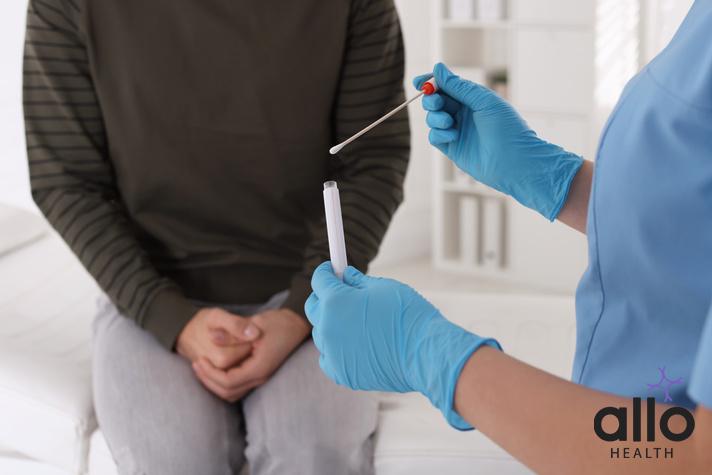Gonorrhea Pharyngitis: Symptoms, Diagnosis, and Treatment

Allo Health is dedicated to personalized well-being, offering support and trusted information tailored to individual health goals. The platform emphasizes human-generated content, led by a distinguished medical team of experts, including physicians and sexual health specialists. Their commitment to credibility involves rigorous fact-checking, authoritative research, and continuous updates to ensure accurate, up-to-date information. Allo Health's unique approach goes beyond conventional platforms, providing expert-led insights and a continuous commitment to excellence, with user feedback playing a crucial role in shaping the platform's authoritative voice.

Dr. Aditi completed her undergraduate medical education at AJIMS, Mangalore, after which she worked in multi-speciality hospitals with COVID patients and in the Pain and Palliative medicine department. Driven by her experiences, she developed a keen interest in psychiatry. Dr. Aditi believes that mental health is just as, if not more important, than physical health.
Why This Was Upated?
Our experts continually monitor the health and wellness space, and we update our articles when new information became available.
Updated on 17 April, 2024
- Article was updated as part of our commitment to diversity, equity, and inclusion.

"The following blog article provides general information and insights on various topics. However, it is important to note that the information presented is not intended as professional advice in any specific field or area. The content of this blog is for general educational and informational purposes only.
Book consultation
The content should not be interpreted as endorsement, recommendation, or guarantee of any product, service, or information mentioned. Readers are solely responsible for the decisions and actions they take based on the information provided in this blog. It is essential to exercise individual judgment, critical thinking, and personal responsibility when applying or implementing any information or suggestions discussed in the blog."
Gonorrhea is a common sexually transmitted bacterial infection caused by Neisseria gonorrhoeae, which primarily affects the genital tract but can also manifest as gonorrhea pharyngitis when it involves the throat. This article explores the various aspects of gonorrhea pharyngitis, including its symptoms, diagnosis, and treatment options, while shedding light on the risks associated with this condition.
What is Gonorrhea Pharyngitis?
- Gonorrhea pharyngitis is a type of gonococcal infection caused by the bacterium Neisseria gonorrhoeae, typically transmitted through oral sexual contact with an infected person. This condition primarily affects the throat and can manifest with symptoms such as a throat pain, painful swallowing, swollen lymph nodes, and pus-like discharge.
- Proper diagnosis of gonorrhea pharyngitis involves a physical examination, sexual history assessment, and specific diagnostic tests like throat swabs and DNA probes to detect N. gonorrhoeae.
- Treatment for gonorrhea pharyngitis typically consists of a single dose of ceftriaxone, administered by a healthcare provider, to eliminate the bacterial infection. Additionally, it may be necessary to prescribe additional antibiotics to address co-infections or antibiotic-resistant strains.
- Untreated gonorrhea, including gonorrhea pharyngitis, can lead to complications such as pelvic infections, permanent damage to the reproductive and urinary tracts, and transmission during childbirth.
- Therefore, accurate diagnosis, proper treatment, and adherence to recommended guidelines are crucial in managing this condition and preventing its spread among sexually active individuals.
Common Symptoms of Gonorrhea Pharyngitis
Gonorrhea pharyngitis, a form of gonorrhea infection in the throat, can present several distinctive symptoms, including:
- Sore Throat: The most common and noticeable symptom is a persistent and often painful sore throat. This discomfort can be particularly bothersome.
- Inflammatory Response: The throat may become sore, swollen, and inflamed due to the body’s immune response to the bacterial infection by N. gonorrhoeae.
- Pus-Like Discharge: Some individuals may observe a pus-like discharge from the throat, which can be a concerning sign.
- Swollen Lymph Nodes: Swollen lymph nodes in the neck may develop as the immune system attempts to combat the infection, and they can be palpable during a physical examination.
- Difficulty Swallowing: In severe cases, gonorrhea pharyngitis can lead to difficulty swallowing, making the act uncomfortable and potentially painful.
It’s crucial to note that these symptoms can overlap with other conditions, highlighting the importance of seeking medical evaluation and accurate tests. A comprehensive assessment of an individual’s sexual history and diagnostic tests, such as throat swabs and DNA probes, is essential for a precise diagnosis and timely treatment to address gonorrhea pharyngitis effectively. Early detection and appropriate treatment are vital to prevent complications and the potential transmission of the infection to sexual partners.
Causes of Gonorrhea Pharyngitis

Gonorrhea pharyngitis, an infection of the throat caused by Neisseria gonorrhoeae bacteria, is primarily transmitted through oral sexual contact, but its causes and risk factors extend beyond that mode of transmission. Here are the causes of gonorrhea pharyngitis:
- Oral Sexual Contact: Engaging in oral intercourse with an infected partner is the most common cause. Neisseria gonorrhoeae can be present in the genital or rectal areas and transmitted to the throat during oral sex.
- Unprotected Sexual Intercourse: Failure to use latex condoms correctly and consistently during oral, vaginal, or anal intercourse increases the risk of infection transmission.
- Multiple Sexual Partners: Having multiple sexual partners or a history of engaging in sexual intercourse with an infected person raises the likelihood of contracting gonorrhea.
- Untreated Gonorrhea Infections: Individuals with untreated gonorrhea infections in the genital or rectal areas can inadvertently transmit the bacteria to their sexual partners’ throats.
- Uncomplicated Gonorrhea: Individuals with uncomplicated gonorrhea infections in other parts of the body, such as the genital tract, can still transmit the bacterium through oral intercourse.
- Lack of Adequate Diagnosis: Inaccurate tests or inadequate diagnostic procedures can lead to undiagnosed or untreated infections, facilitating the spread of gonorrhea.
- Vertical Transmission: Pregnant women with gonorrhea can transmit the infection to their newborns during childbirth, potentially leading to gonorrhea pharyngitis in infants.
It’s crucial for sexually active individuals to be aware of these causes and risk factors, practice safe sex, undergo regular testing, and seek prompt medical attention if experiencing symptoms or potential exposure to gonorrhea pharyngitis to mitigate its spread and impact.
Diagnosing Gonorrhea Pharyngitis

Diagnosing gonorrhea pharyngitis, a sexually transmitted infection caused by Neisseria gonorrhoeae, involves a combination of methods and considerations:
- Throat Swabs: Health care providers can perform throat swabs to collect samples from the infected area. These swabs are crucial for detecting the presence of N. Gonorrhoeae in the throat, as the bacterium can cause gonorrhea pharyngitis.
- DNA Probe Testing: DNA probe tests are highly specific and can accurately identify the genetic material of N. gonorrhoeae in the collected throat swab samples. This method ensures an accurate diagnosis of gonorrhea pharyngitis.
- Sexual History: Gathering a detailed sexual history from the patient is essential. Understanding the individual’s sexual practices, risk factors, and potential exposure to infected partners helps in assessing the likelihood of gonorrhea pharyngitis.
- Additional Tests: In addition to diagnosing gonorrhea, it is often recommended to test for other sexually transmitted infections (STIs) such as chlamydial infections, syphilis, and viral infections. This comprehensive testing approach ensures that all possible STIs are considered and treated if present.
- Clinical Diagnosis: Physical examination of the throat and neck may reveal signs of infection, including redness, swelling, and pus-like discharge. Swollen lymph nodes in the neck may also be indicative of gonorrhea pharyngitis.
Accurate diagnosis is crucial to provide appropriate treatment and prevent further transmission of the infection. Health care providers should employ these diagnostic methods while considering the patient’s sexual history and risk factors to ensure an adequate and thorough assessment of gonorrhea pharyngitis.
Treatment Options
Treatment options for gonorrhea pharyngitis, a throat infection caused by the bacterium Neisseria gonorrhoeae, primarily involve antibiotics and follow-up care.
- Antibiotics: The cornerstone of gonorrhea pharyngitis treatment is antibiotics. A healthcare provider typically administers a single dose of ceftriaxone, as it remains highly effective against most gonococcal strains. This antibiotic is vital in combatting the bacterial infection in the throat.
- Additional Antibiotics: Depending on individual cases, health care providers may prescribe additional antibiotics to cover potential co-infections, antibiotic-resistant gonorrhea strains, or other sexually transmitted infections such as chlamydial infections or syphilis. This comprehensive approach ensures all infections are adequately addressed.
- Follow-up Testing: After receiving treatment, it is essential to return for follow-up testing to confirm that the infection has cleared. This step helps ensure the effectiveness of the antibiotics and reduces the risk of complications.
- Pain Relievers: Over-the-counter pain relievers, like ibuprofen or acetaminophen, can be used to alleviate throat discomfort associated with gonorrhea pharyngitis.
- Adherence to Treatment: Patients must strictly adhere to the prescribed treatment regimen and complete the full course of antibiotics. This ensures that the infection is fully eradicated, reducing the risk of reinfection or the emergence of antibiotic-resistant strains.
Proper treatment of gonorrhea pharyngitis is crucial not only for the individual’s health but also for preventing the spread of the infection to sexual partners. It is important to consult a healthcare provider for accurate diagnosis and appropriate antibiotic therapy, as self-medication may lead to incomplete treatment and potential complications.
Prevention and Precautions
Preventing and taking precautions against gonorrhea pharyngitis, a sexually transmitted infection, is crucial to safeguard one’s health and reduce transmission risks. Here are key prevention measures and precautions:
- Safe Sexual Practices: Consistently use latex condoms during vaginal, anal, and oral intercourse to reduce the risk of gonorrhea transmission through sexual contact. This includes using the correct condom and using it every time.
- Regular Testing: Individuals with multiple sexual partners or engaging in high-risk sexual practices should undergo regular diagnostic tests for gonorrhea and other sexually transmitted infections. Testing should occur days after infection or potential exposure.
- Open Communication: Maintain open and honest communication with sexual partners about sexual history and previous partners. This can help identify potential sources of infection and enable partners to seek testing and treatment if necessary.
- Health Care Provider Visits: Seek prompt medical attention if experiencing symptoms of gonorrhea pharyngitis, such as a sore throat, pain during swallowing, or pus-like discharge. Early diagnosis is crucial for adequate treatment.
- Complete Treatment: Adhere to the recommended treatment plan provided by a health care provider. Completing the full course of antibiotics as prescribed is essential to ensure the infection is fully cleared.
- Partner Notification: If diagnosed with gonorrhea, cooperate with health departments to notify and test previous sexual partners to prevent further transmission within sexual networks.
- Preventing Antibiotic-Resistant Strains: Due to emerging antibiotic-resistant gonorrhea strains, accurate diagnosis and appropriate antibiotic administration are vital to avoid treatment complications.
By following these preventive measures and precautions, individuals can significantly reduce the risk of contracting gonorrhea pharyngitis, protect their sexual partners, and contribute to the overall reduction in the spread of gonorrhea and antibiotic-resistant strains in the adult population.
Conclusion
Gonorrhea pharyngitis is a significant concern, especially among sexually active individuals. Early and accurate diagnosis, along with proper treatment, is crucial to prevent complications, the spread of the infection, and the emergence of antibiotic-resistant strains. Practicing safe sex and maintaining open communication with health care providers are essential steps in mitigating the risks associated with gonorrhea pharyngitis.
Most Asked Questions
-
What are the common signs of gonorrhea pharyngitis?
Gonorrhea pharyngitis can cause a sore throat, swelling, pus-like discharge, and difficulty swallowing. Swollen lymph nodes in the neck can also occur.
-
How is gonorrhea pharyngitis diagnosed?
Doctors typically use a physical exam, ask about your sexual history, and perform tests like throat swabs and urine samples to detect the infection.
-
What’s the treatment for gonorrhea pharyngitis?
The primary treatment is antibiotics, usually a single dose of ceftriaxone. Pain relievers can help with throat discomfort, and follow-up testing is important.
-
How can I prevent gonorrhea and its complications?
You can reduce the risk by using latex condoms, getting regular STI tests, notifying previous partners if diagnosed, and following treatment recommendations from your healthcare provider.






































